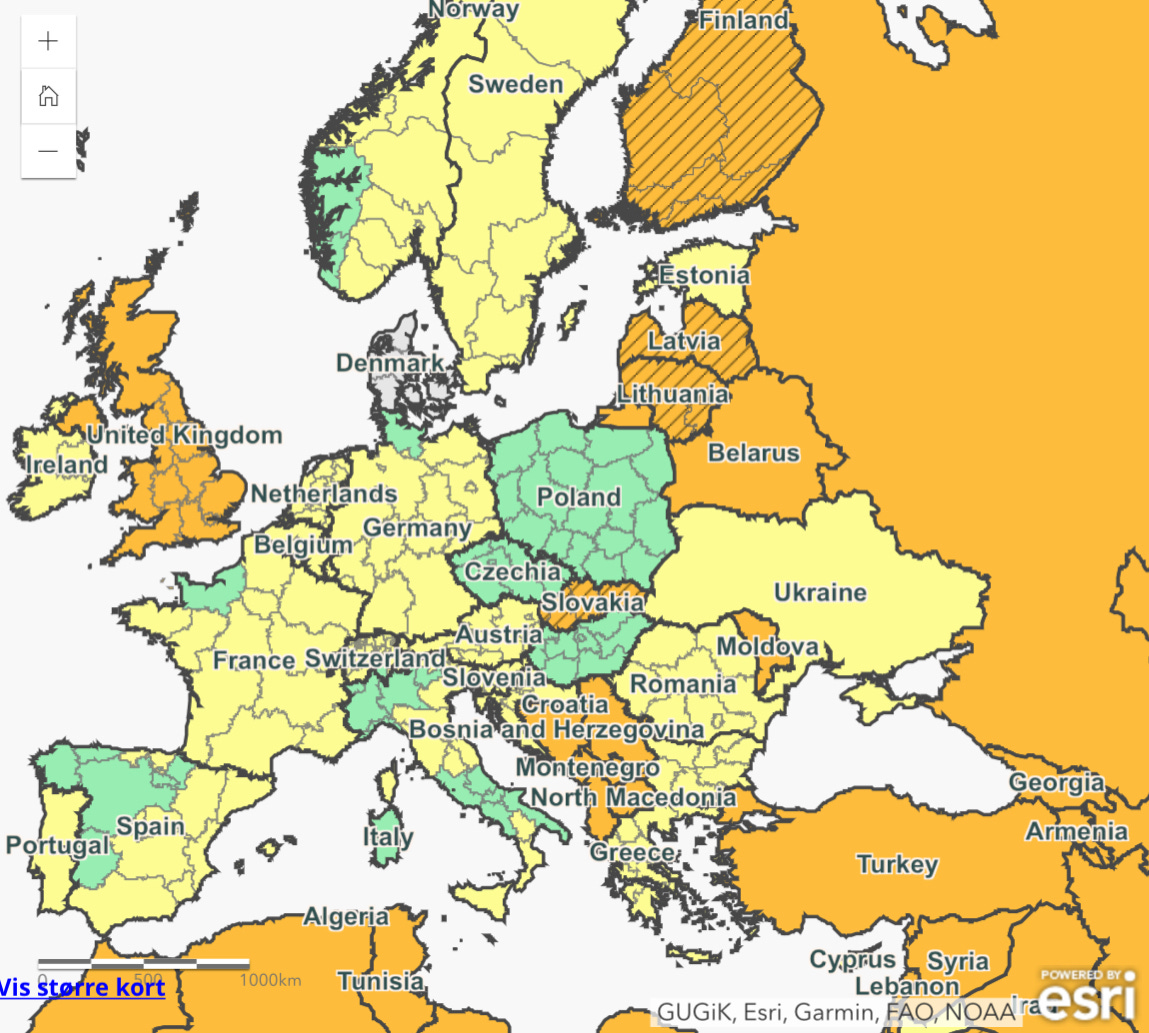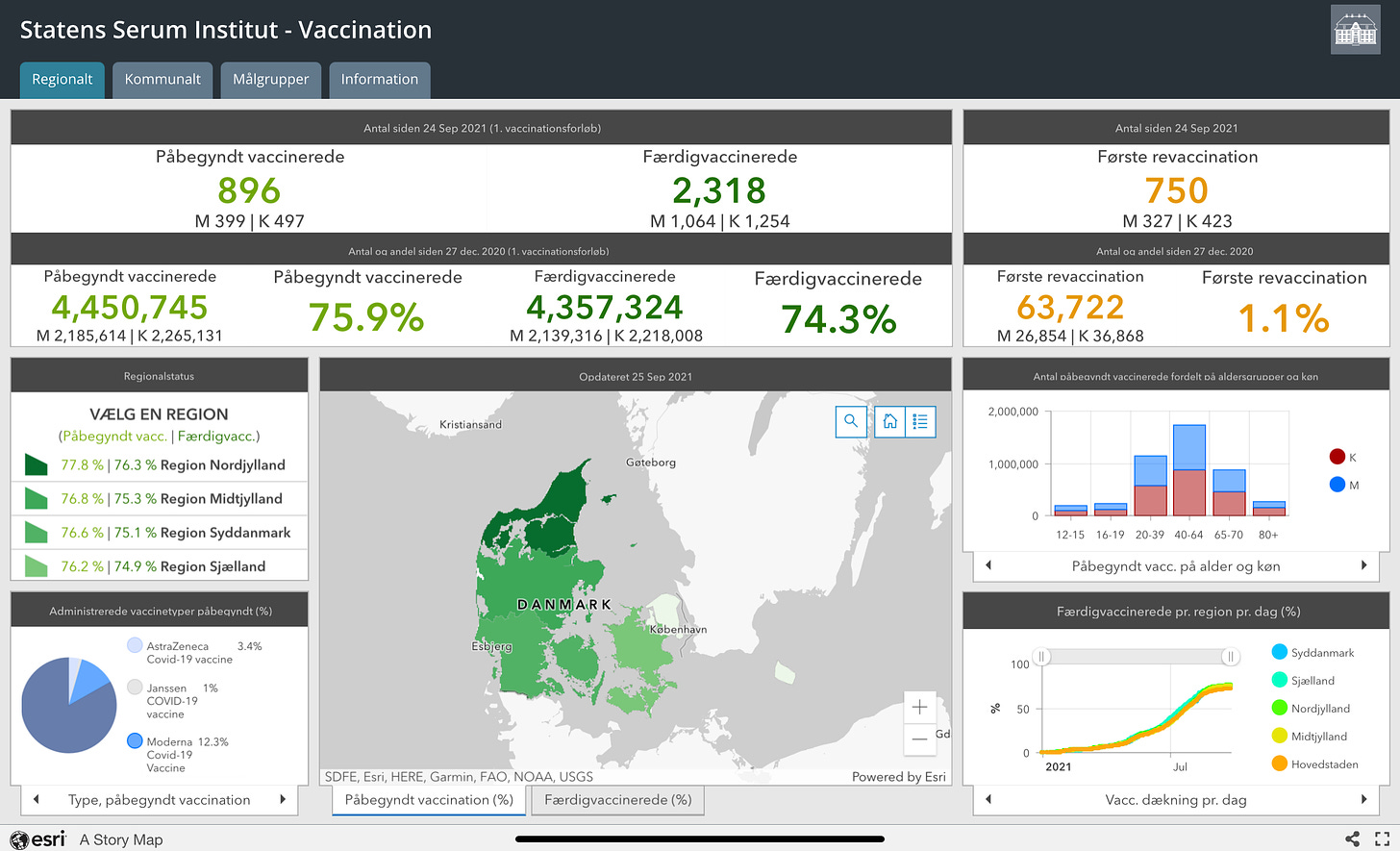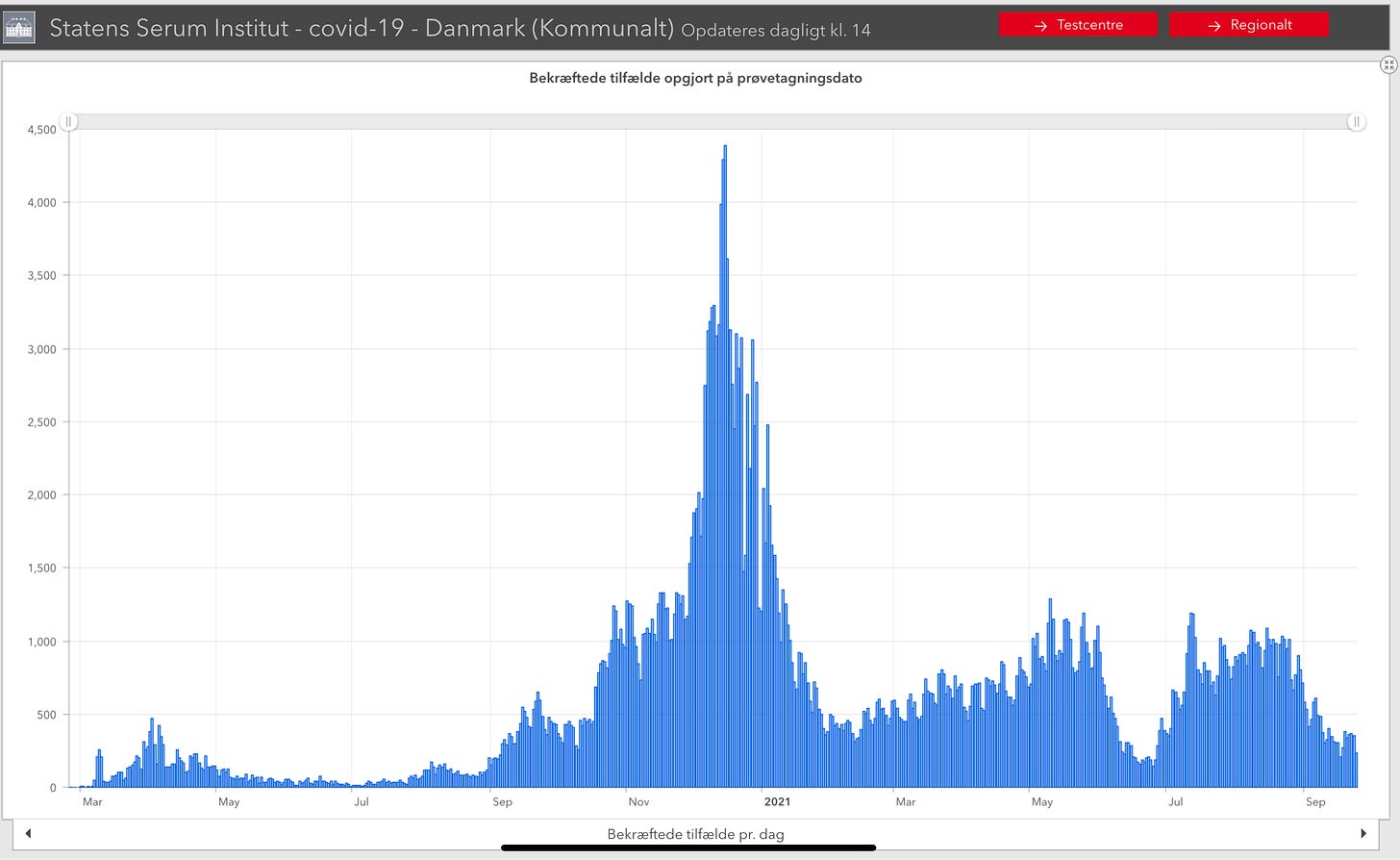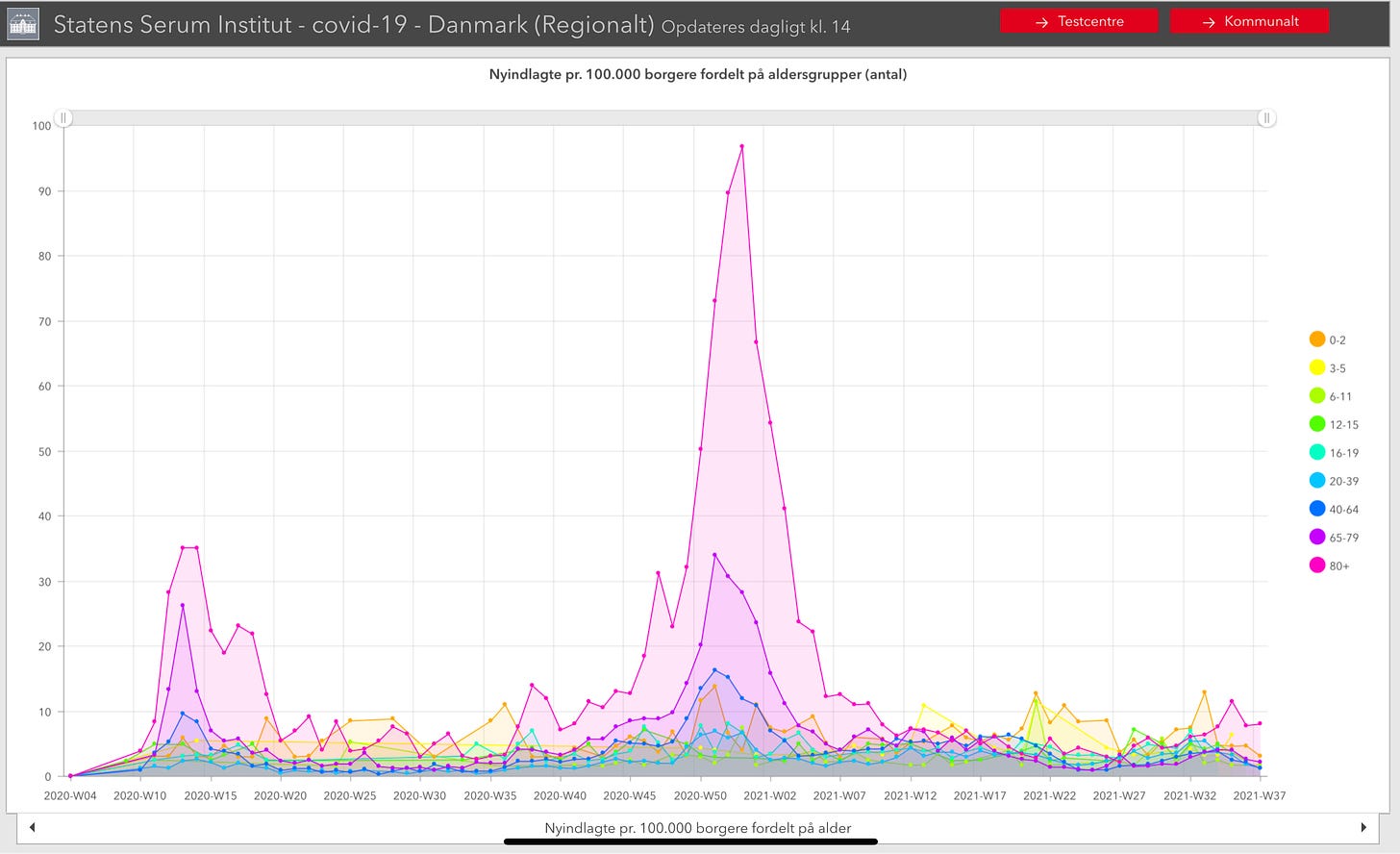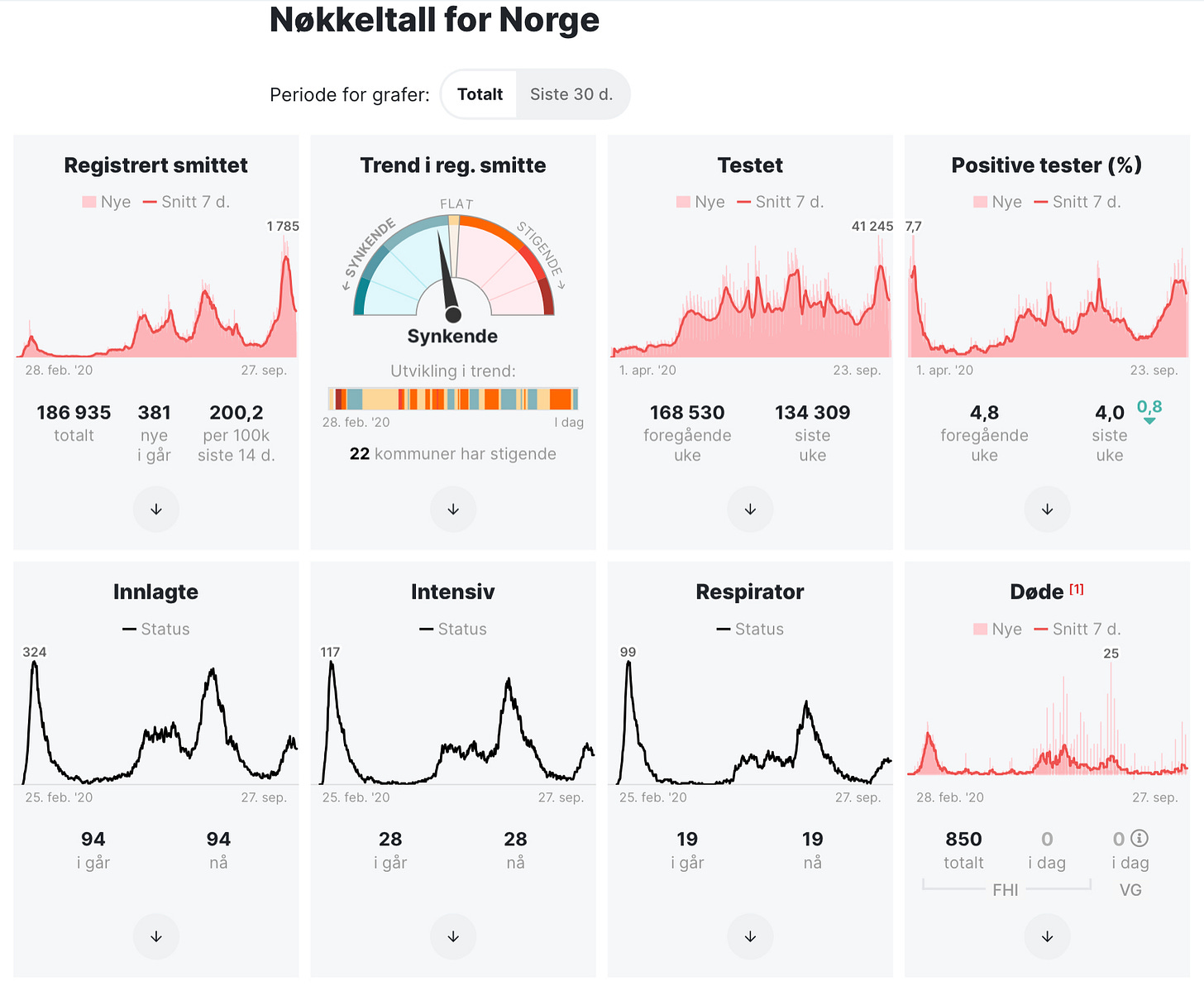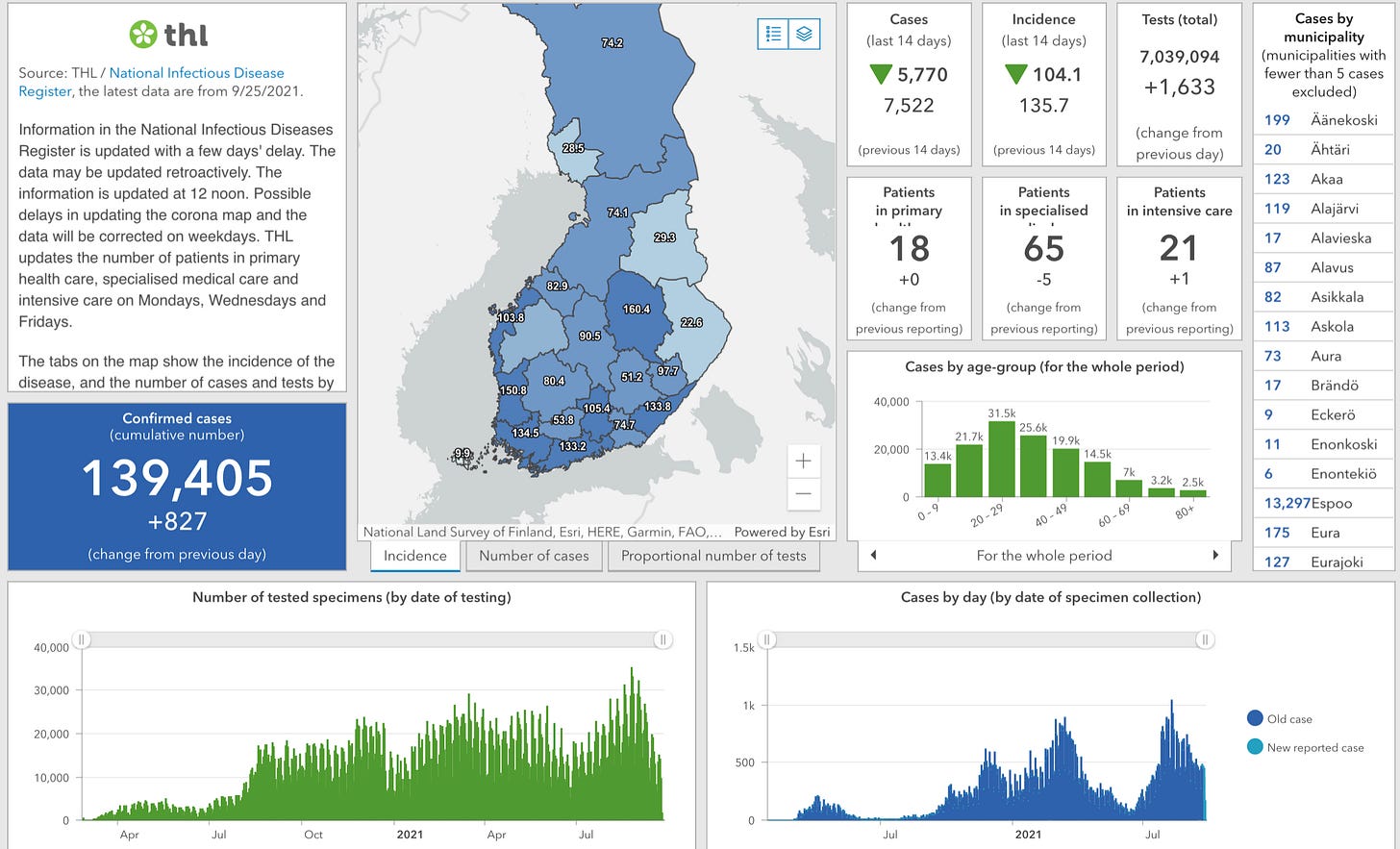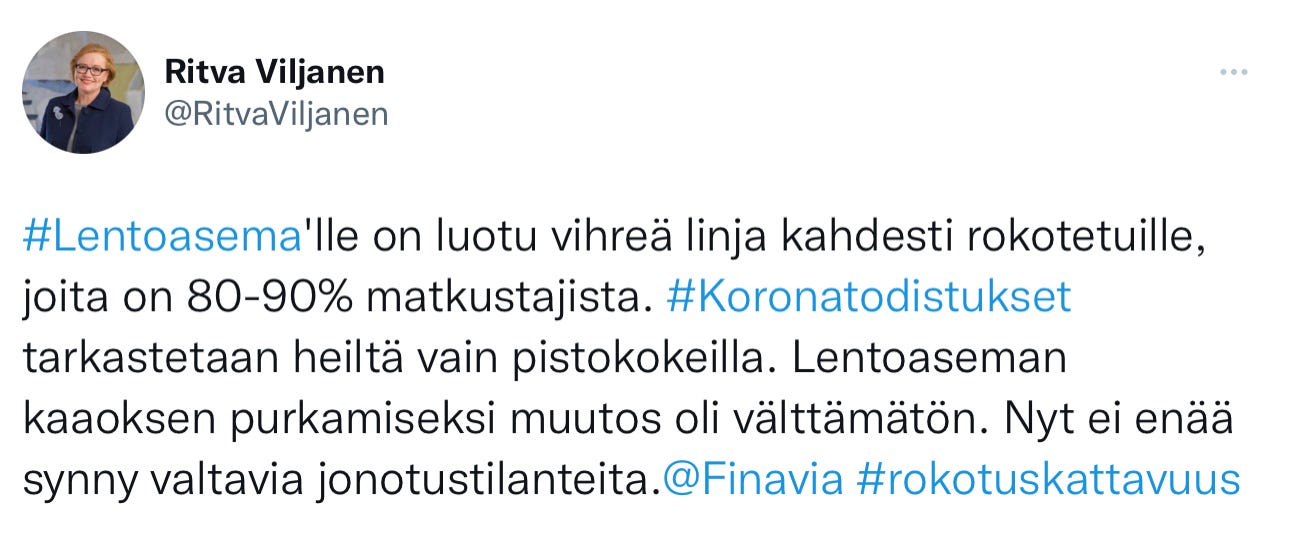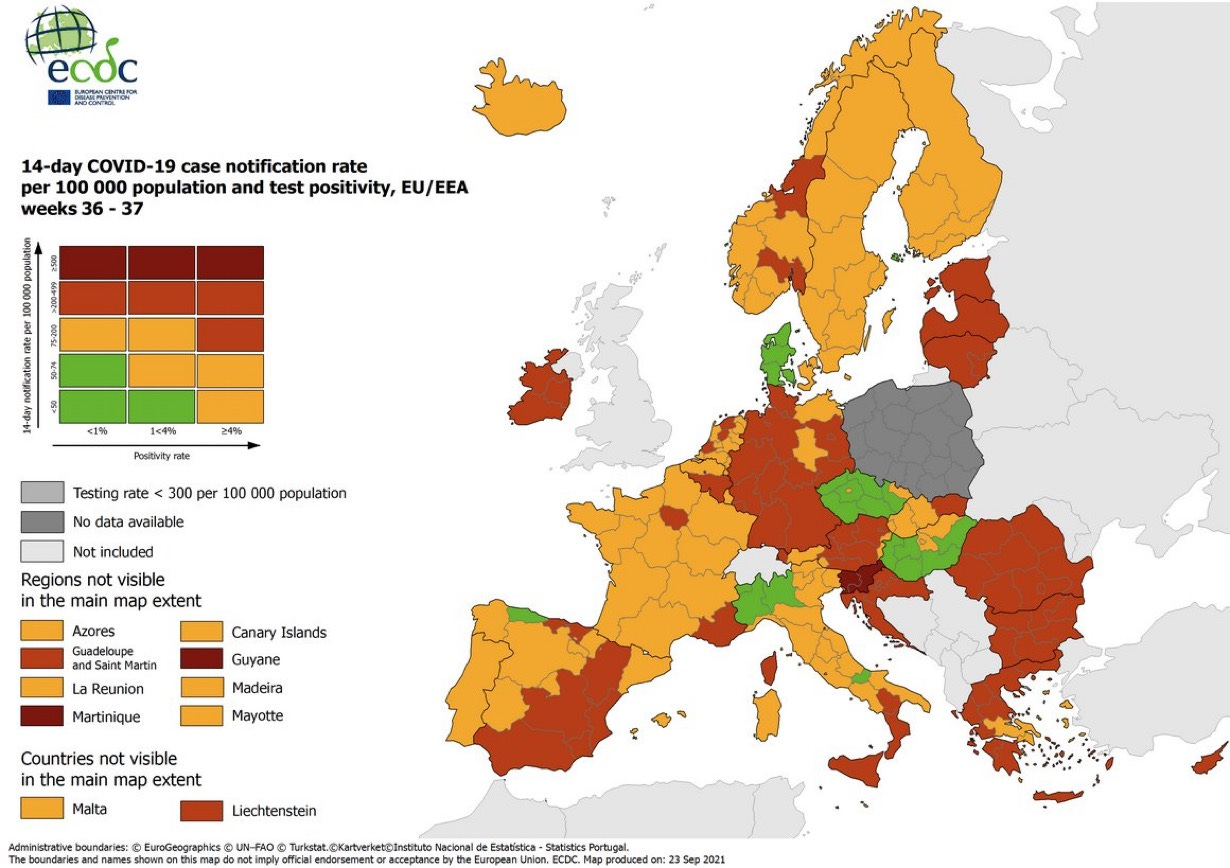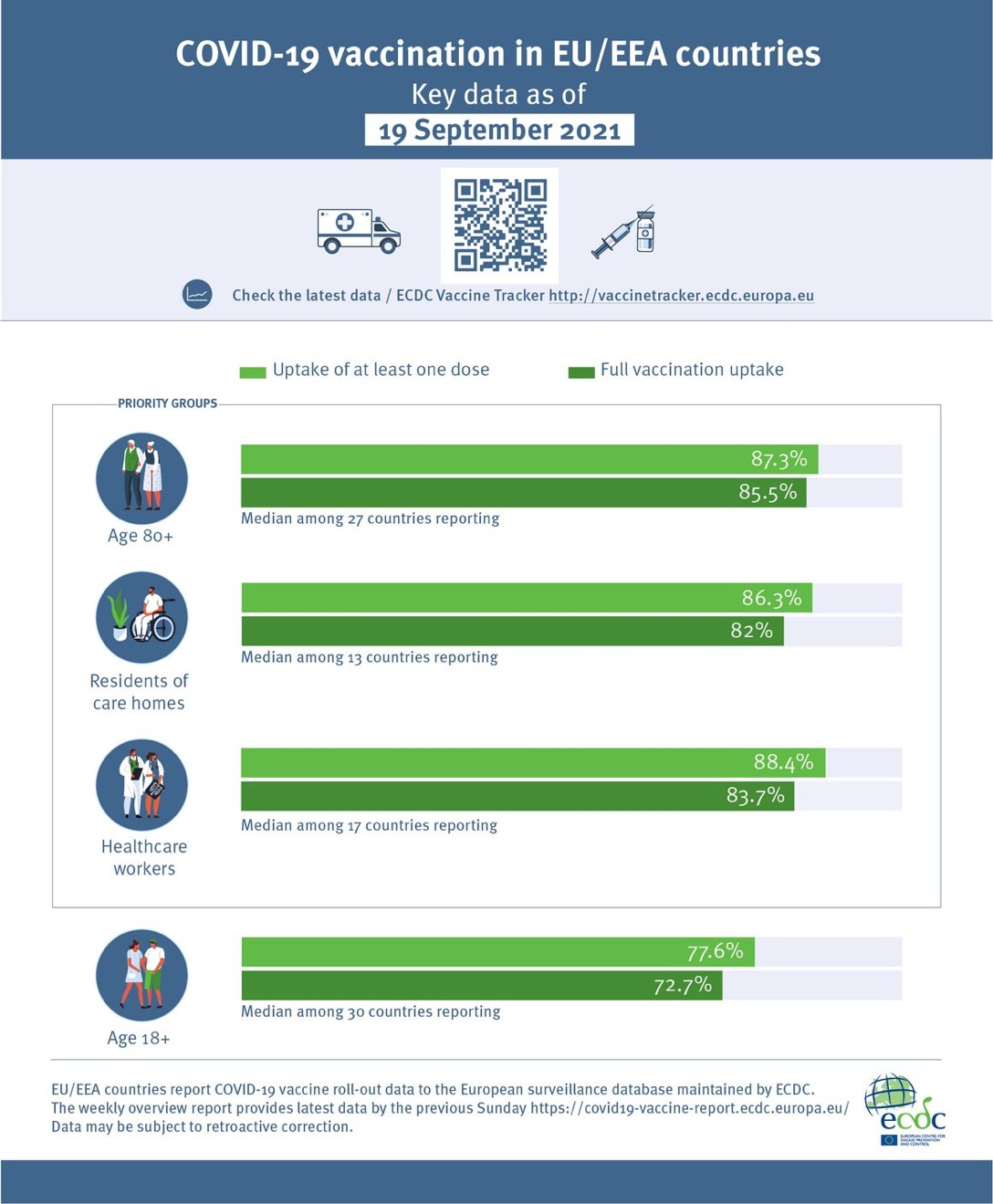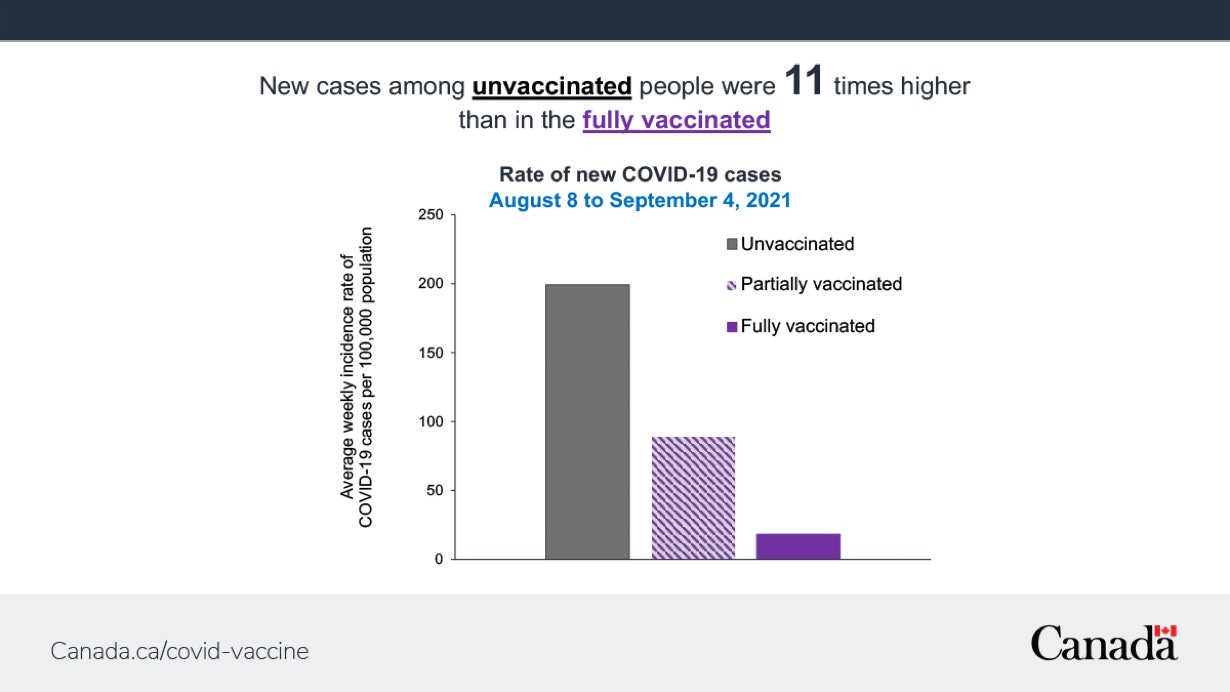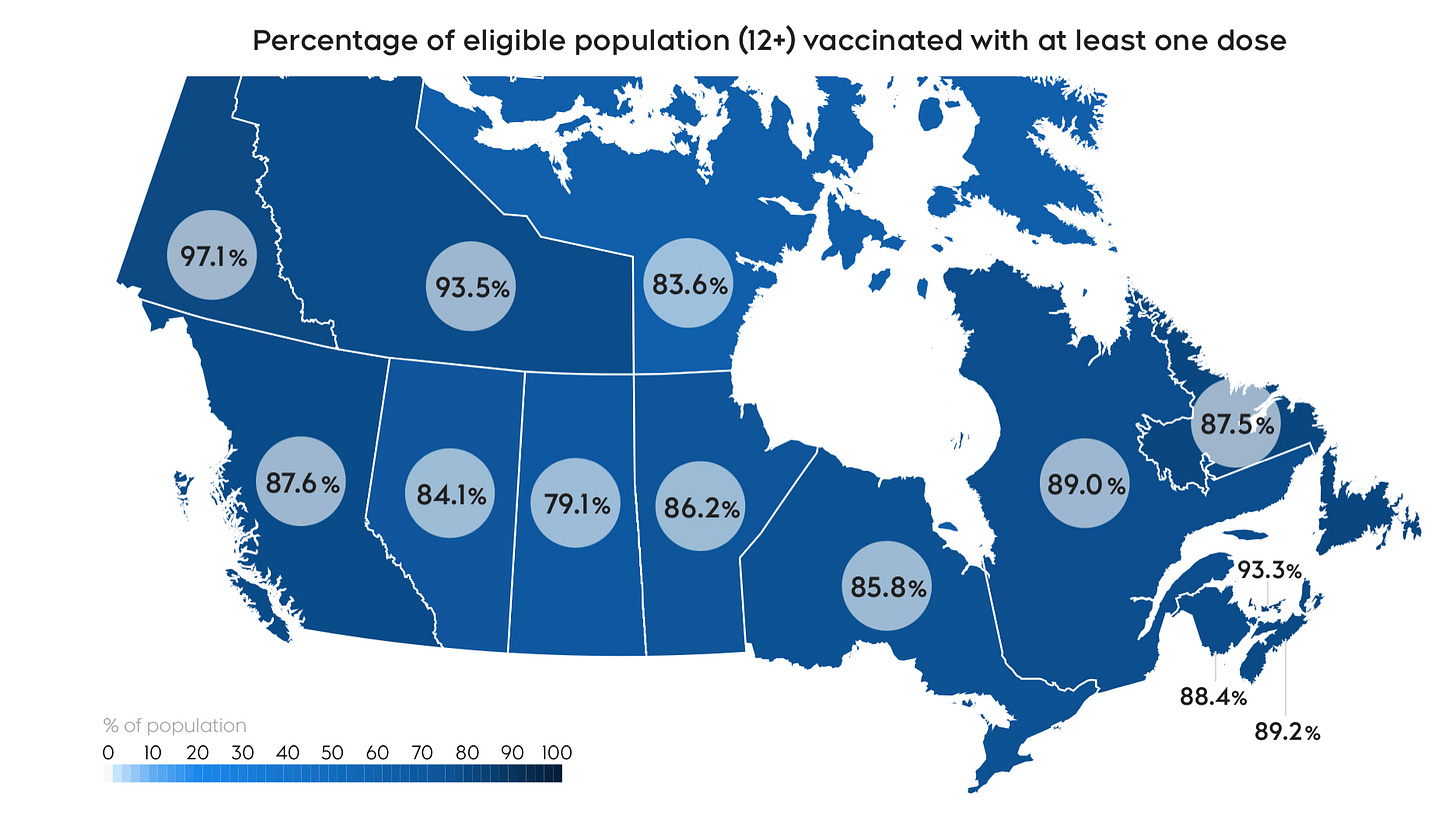🇩🇰
Denmark’s Health Ministry says there are far fewer beds occupied by COVID patients in hospitals across the country, but those beds are now being taken by people struggling with RS virus infections. It says the virus is not only arriving months earlier than ever before, and being seen in much higher numbers than ever seen before it is also causing “significant” pressure on hospitals, especially pediatric wards. That said, it notes, the “sharp increase” in RS virus infections seen in the last month or so has begun to stabilize.
Deputy Director Helene Probst:
“We will monitor the number of hospitalizations due to infectious diseases in the autumn and winter, so that we, together with the regions, can intervene if necessary. Right now, the number of hospitalized children with the RS virus is significantly higher than in previous years, but fortunately the regions are now reporting a slightly declining trend.”
The health ministry also adds that the “vast majority” of COVID hospital patients are people who are unvaccinated despite the fact that only make up 13% of the population 12 years old and older.
“On the other hand, the number of inpatients with COVID is falling. This is very gratifying, but at the same time we just have to say that if you have not been vaccinated against COVID, you run a serious risk. We can see that some of those who have previously been infected have yet to go get vaccinated.”
It adds there are very few hospitalizations related to influenza and pneumococcal disease, but the ministry expects to see those numbers increase before year end.
-
The Danish Foreign Affairs Ministry has updated its COVID risk assessment travel map. Perhaps the most significant change for people traveling from Denmark is that Norway has become low-risk yellow, but there are some nuances. All travelers, even those who are not vaccinated, can travel to Norway without the requirement for a COVID test on arrival, with one exception. Travelers from Denmark’s capital region (Region Hovedstaden) who are not vaccinated must quarantine with an out if they have a negative test on day three. All unvaccinated children from areas/countries requiring a quarantine must also get tested at the border.
For people traveling to Norway from Denmark, they must be aware of the differences between regions. The Norwegian regions of Rogaland and Vestland are near-normal green, while all others are low-risk yellow. Unvaccinated travelers returning from a yellow region must get tested when they return to Denmark.
Elsewhere in the European Union, a number of different regions are now green. They include the Normandy region of France, Liguria and Sardinia in Italy, along with the regions of Galicia, Navarre, La Rioja, Castilla y León, and Extremadura, and finally the Ticino region of Switzerland.
Outside the EU Bosnia and Herzegovina and Moldova both turn medium-risk orange as infection rates climb in both.
-
Danish Health Minister Magnus Heunicke said on Friday that seven out of every ten nursing home residents have now had a third COVID vaccine booster shot. This equates to 72.9% of the nursing home population or 28,052 people.
-
On the vaccination front, so far, enough, first vaccine doses have been administered to cover 75.9% of the entire population while 74.3% are fully vaccinated. Just 93,421 vaccinations separate first and second doses administered.
On Saturday there were just 3,214 total vaccinations done, of which a mere 896 were first doses.
The Staten Serum Institut is now including booster shot statistics. To date, 63,722 third vaccine doses have been administered.
Sundhedsstyrelsen Deputy Director Helene Probst:
“Re-vaccination of the most vulnerable citizens in our society is a top priority for us, which is why it is good to see that progress is being made so quickly. We have the advantage here in the re-vaccination effort that we can build on all the experiences we gained and lessons learned from the roll-out general vaccination program. It is worth its weight in gold.”
-
Region Nordjylland is downsizing its vaccination infrastructure. As of October 4 the region will go from six brick-and-mortar vaccination sites down to four. Of those four, most will also be moving locations.
Currently, the region has vaccination centers in Aalborg, Hjørring, Frederikshavn, Thisted, Hobro, and Aars, of which the ones in Frederikshavn and Aars will close on October 4. While three of the other four will change addresses and all will have opening hours adjusted.
Chief Consultant Anders Cinicola:
“North Jutland is the region in the country that has the highest support for the vaccination program in Denmark, both in terms of those with one dose and fully vaccinated citizens, but we are still working to improve the vaccination rate, even though the number of permanent vaccination centers is now being reduced.”
The region will also continue to lean on its mobile vaccination sites, which will continue to operate pop-up vaccination sites across the region.
-
Denmark has added 1,093 COVID infections and four more coronavirus deaths since its Thursday update. 382 infections were reported on Friday, 358 on Saturday, followed by another 353 on Sunday.
-
COVID hospitalizations (85) have risen day to day (+8) while the number of infected in an ICU (17) have dipped slightly (-1) and of those the number on a ventilator (11) is unchanged.
-
COVID infections continue to pop up in Danish nursing homes despite having some of the highest vaccination rates in the country. According to the Staten Serum Institut, 19 elderly residents of nursing homes died from coronavirus in the first three weeks of September. That is the highest number since February. The infection activity and deaths have touched off a political debate in Denmark about whether to require frequent mandatory COVID testing of all staff and any visitors to those homes.
-
Denmark’s Lego Foundation has donated 444 million Danish kroner (just over $88 million Cdn) to the international COVAX vaccine initiative. The COVAX program works to secure coronavirus vaccines for the world’s poorest countries. UNICEF Denmark, which helps with the COVAX effort, says the money will help fully vaccinate some 14 million people.
🇸🇪
Sweden will table its first COVID update of the week on Tuesday.
-
Swedish Prime Minister Stefan Löfven did some bobbing and weaving on CNN trying to defend his country’s COVID strategy. The Prime Minister admitted to the obvious that compared to all his country’s Nordic neighbours that there are exponentially more infections and coronavirus deaths in Sweden. But added that it is a marathon, not a sprint.
“I would not say that [we were] relaxed. It is not a fair choice of words. It is true that compared to Norway, Finland, and Denmark we had higher numbers, but when we saw the pandemic develop last spring, we said that it is a marathon. It will not end in the summer of 2020, but will last a long time, which it has done.”
Löfven insists it is still too early to draw any conclusions on Sweden’s coronavirus strategy.
Sweden has more than three times the COVID deaths of Denmark, Norway, and Finland combined. Its highly criticized COVID strategy resulted in officials, including the Prime Minister, apologizing for failing seniors in care who bore the brunt of COVID deaths in the first two waves. The coronavirus strategy was only abandoned when the country’s king called the strategy a failure that had caused too much suffering and too many Swedish lives in his annual Christmas address.
-
Sweden is also seeing nursing home deaths increase again, and an analysis obtained by Svenska Dagbladet points the figure at unvaccinated staff. The analysis comes from The Swedish Public Health Agency and found Region Stockholm had the lowest rates of nursing home employees who are vaccinated. In Sweden’s capital region, only 53% of senior care home staff and 64% of nursing home employees are vaccinated.
This may be a significant contributing factor to a spate of elderly residents dying from COVID despite the majority having had both doses.
🇳🇴
Norway has added 1,993 infections and had no new corona deaths since its Thursday update.
COVID hospitalizations (94) have fallen (-6) while the number of infected people in an ICU (28) is also down (-5) and of those the number on a ventilator (19) has inched upward (+1).
To date, 76.48% of Norwegians 12 years old and older have had one vaccine dose, while 66.86% have had both.
-
“The time is here. We are returning to normal everyday life.”
The words of Norwegian Prime Minister Erna Solberg when she announced most of Norway’s COVID restrictions would be lifted this past Saturday.
“Now we can live almost as we did before the pandemic hit us. I do not think everything will be as before. I think coronavirus will affect us for the rest of our lives, for better or worse. We have learned how vulnerable we are.”
Among the restrictions being lifted were limits on gatherings, social distancing, and any rules prohibiting nightlife venues from operating as normal.
People who test positive will still be required to quarantine at home. Norway’s traffic light system rating COVID risk at schools and dictating countermeasures will remain in place. As well COVID-related entry restrictions and other travel rules will also hold fast.
Norwegian municipalities will also still retain the power to levy local restrictions and mandate things like mask use and limits on gatherings.
NIPH Director Camilla Stoltenberg also stresses that any holdouts need to go get their shots as being fully vaccinated offers the best protection against serious illness, hospitalization, and death.
“At the same time, it is important to note that we have not yet reached the goal that 90% of the population over the age of 18 should be fully vaccinated. The vaccination rate is now almost 84%. If you are not fully vaccinated, then go get vaccinated.”
-
The Norwegian Institute of Public Health has shortened quarantine times for those who test positive for coronavirus.
Department Director Line Vold:
“After assessing new studies and after most of the population has been vaccinated, the National Institute of Public Health has advised the government that it is justifiable to shorten the isolation period. The infectiousness of the coronavirus usually starts a few days before the symptoms, is highest approximately when the symptoms come, and then decreases within a few days.”
These are the new rules:
An infected person regardless of vaccination status, must quarantine after a positive test. They can end quarantine five days after symptoms began, provided they have not had a fever for at least 24 hours.
For someone who is not fully vaccinated, has tested positive, and is asymptomatic, then the five days of quarantine are counted from the day they tested positive.
For people who are fully vaccinated who test positive, they should isolate for two days unless further symptoms develop.
🇫🇮
Finland registered 1,811 infections over the last three days. It reported 474 cases on Friday, 510 on Saturday, and another 827 on Sunday.
So far, Finland has administered 4,125,076 1st vaccine doses (73.7% of the total population) and 3,391,594 people (60.7%) are fully vaccinated.
-
The Chief Physician of the Helsinki and Uusimaa Hospital District is warning about the usual flu and RS virus seasons to come. Asko Järvinen says that due to COVID restrictions, all but eliminating previous flu and RS virus seasons, both could now come roaring back. He says months of isolation, restrictions, and a lack of social contact things like the influenza season, were all but eliminated. Now, with more normal life resuming and lower immune system protection, this year’s usual virus seasons will be more severe than usual.
Järvinen spoke to YLE:
“We should remember that hundreds of people die every year from the flu. Personally, I recommend the flu vaccine to everyone.”
-
Helsinki Airport is looking to expedite the arrival of fully vaccinated travelers. According to YLE, the airport will set up a green line for people who have had both doses. Ritva Viljanen, the Mayor of Vantaa, where the airport is located, says fully vaccinated travelers make up 80 to 90% of all arrivals. She adds proof of vaccination will only be checked randomly to try and prevent huge backlogs processing incoming travelers.
“The change was necessary to alleviate chaos at the airport. Now there will no longer be huge queuing situations.”
Airline operator Finavia had previously warned that screening travelers for vaccination status would become impossible as passenger numbers increased.
From a recent statement:
“When vaccination coverage in Finland is already at a good level and the majority of newcomers are vaccinated, comprehensive screening activities are no longer justified from the point of view of epidemic management. The certificates of passengers arriving at the airport have, for the most part, already been checked once by the travel operators, and, in any case, the majority already have full vaccination protection.”
🇫🇷
France has followed the lead of Denmark and the United States and announced it will double its donations of COVID vaccine doses to poorer countries. This means the current 60 million doses France has earmarked for developing countries will become 120 million doses. French President Emmanuel Macron made the news official at an event on Saturday.
The World Health Organization has continuously sounded the alarm about global vaccination inequality, with richer countries eating up the worldwide supply of vaccines.
🇪🇺
Here is the latest COVID travel risk assessment map from the European Centre for Disease Prevention and Control. Of note, Denmark is now near-normal ‘green.’
Also from the ECDC is a snapshot of vaccination rates in the European Union.
💉
Pfizer is ready to apply to the US Food and Drug Administration for an authorization of use for its COVID vaccine among children 5 to 11 years old “within days”. Pfizer CEO Albert Bourla broke the news in an interview on ABC on Sunday. The move further signals the possible vaccination of young children could start within months in some jurisdictions.
The company recently touted highly successful clinical trial results among young children. However, the data for those clinical trials has yet to be made public.
🇨🇦
The Canadian COVID dashboard has not been updated since Friday.
-
Canada’s Chief Public Health Officer Dr. Theresa Tam is again urging people to get vaccinated. Tam points to the latest data showing that fully vaccinated people are much less likely to become infected. She says weekly case numbers from August 8 to September 4 show that infection rates among unvaccinated people were 11 times higher than those who had both doses. In fact, just 0.10% of fully vaccinated people were infected that week.
Tam also emphasized that fully vaccinated people are much better protected against suffering serious cases of COVID, with hospitalization rates 38 times higher for unvaccinated people versus those vaccinated.
-
On the vaccination front to date, 28,989,972 1st vaccine doses (76.14% of the total population) have been administered, while 26,753,831 people (70.27%) have had both doses.
Of the provinces that reported over the weekend:
Ontario recorded 1,293 infections over the weekend. Of those, 984 were among people who were unvaccinated or who had a single dose. There are 198 people in hospital and 177 are in intensive care.
Quebec reported 1,514 infections and seven more corona deaths over Saturday and Sunday.
In Atlantic Canada, New Brunswick 143 COVID cases on Saturday and Sunday. Most of the new infections are among unvaccinated people. Sundays 82 infections are the highest daily number of COvID cases in New Brunswick of any day of the pandemic yet. Newfoundland and Labrador had 38 infections over the weekend.
There were 1,099 infections in Saskatchewan over the weekend, along with seven more virus deaths.




